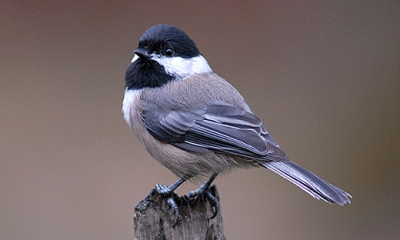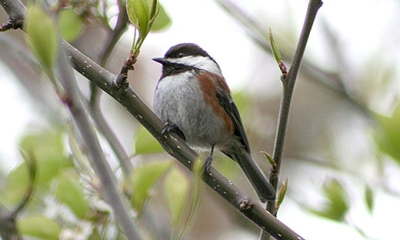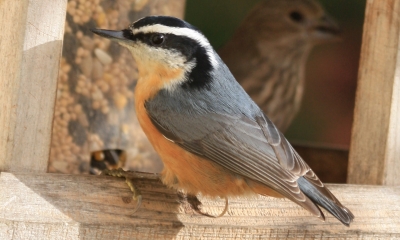
Chickadees and Nuthatches
Various species of chickadees and nuthatches are found throughout Oregon.

Types of Chickadees and Nuthatches

Noted for its familiar call, chick-a-dee-dee-dee, the Black-capped chickadee is widely heralded as one of Oregon's friendliest and cheeriest residents. Even in the midst of winter, this bird "fairly overflows with good spirits."
The Black-capped chickadee is resident at low to moderate elevations in western Oregon from the Willamette Valley and coastal counties to Douglas County and in most of eastern Oregon with the exception of the southeastern corner of the state.
Hear the song of the Black-capped chickadee
Photo by Dave Budeau, ODFW

An acrobatic flier with a dashing white eye-stripe, the Mountain chickadee is a common year-round resident of Oregon's high-elevation coniferous and mixed forests. This species is distinguished from other North American chickadees by its white eyebrow, gray flanks, and gray undertail coverts and by its drawling, hoarse-sounding chick-a-dee-dee-de call.
It is resident in all types of forests from two to 10 miles west of the Cascades summit and east, in the Blue, Siskiyou, Wallowa and Warner mountains and on Hart, Steens and other isolated mountains east of the Cascades.
Hear the song of the Mountain chickadee
Photo by Simon Wray, ODFW

Chestnut-backed chickadees are one of the most common species of bird in conifer forests of western Oregon. They are distinguished from other chickadees by their chestnut-colored back, lack of an eye-line, and their wheezy song.
Like other chickadees, they are frequently observed performing acrobatic maneuvers such as hanging from branch tips while foraging high in the canopy.
They also frequent bird feeders for suet and sunflower seeds, and will nest in boxes if they are placed near groves of conifers.
Hear the call of the Chestnut-backed chickadee
Photo by Kathy Munsel, ODFW

This species reaches the northern limit of its range in southwest Oregon. Oak and Juniper titmice were formerly in the same species as the Plain titmouse but were recognized as a separate species in 1997. The drab, gray color with distinct crest and chickadee-like calls and behavior characterizes these species. Plumage of sexes is identical.
The Oak titmouse is a friendly, high-spirited, and melodious bird of oak-dominated habitats of interior valleys and lowlands. It is a common resident in oak woodlands of the interior Rogue Valley, and a rare but permanent resident in Illinois Valley.
Hear the call and song of the Oak titmouse
Photo by Larry Jordan, Flickr

The Juniper titmouse presents the demeanor of a miniature jay with its crest jutted proudly upright. It is a pale gray bird above and underneath, with little or no brown coloration. Songs and calls are useful in locating hidden titmice. The Juniper titmouse occurs in pinyon pine-juniper woodlands in the bulk of its range.
This bird is a cavity nester. The nest is often placed in a crevice of a twisted trunk of large, older junipers. It primarily forages in junipers and juniper seed are important in the winter diet.
An Oregon Conservation Strategy Species in the Northern Basin and Range ecoregion, the Juniper titmouse occurs in scattered isolated populations east of the south Cascades to Idaho. It is an uncommon resident east of Lakeview and Albert Rim, on Hart Mountain, North Antelope Ridge, southern Warner Valley and west of Adel Lake.
Hear the song of the Juniper titmouse
Photo from Seabamirum, Flickr

A group of twittering, tiny gray birds streaming through bushes and trees and across openings surely are Bushtits.
Females' eyes are pale, males' dark. They are highly gregarious except when nesting. The intricately made sock-like nest is unusually large for the size of the bird.
Bushtits show a distinct indifference to humans and regularly nest within residential neighborhoods and establish foraging routs throughout many cities. They regularly take suet at bird feeding stations and visit backyard birdbaths.
The Bushtit is a fairly common resident throughout Oregon except in Umatilla, Union, and Wallowa counties and at higher elevations of mountain ranges, where it is a rare fall visitant.
Photo by Dave Budeau, ODFW

The Red-breasted nuthatch is a happy, jolly little bird, quick and agile in its motions and seemingly always in a hurry to scramble over the branches. It is distinguished from other nuthatches by white eyebrows, black eyelines and cap, reddish breast, and nasal yank yank song. Although males have a blacker cap and redder breast than females, distinguishing sexes in the field is difficult. During winter, is can be observed foraging in mixed-species flocks with Chickadees, Brown creepers, Kinglets, Townsend's carblers, and Dark-eyed junkos.
The Red-breasted nuthatch breeds and winters throughout Oregon where conifer or mixed conifer-hardwood forests are present, including some urban areas. It winters in wooded areas from valley floors to timberline. Migratory individuals are encountered widely in areas where they do not breed.
Hear the call of the Red-breasted nuthatch
Photo by Kathy Munsel, ODFW

Among the largest of the world's nuthatches, White-breasted nuthatches also are noteworthy for an extensive repertoire of unusual behaviors and habits.
Unlike most other North American passerines, White-breasted nuthatches maintain close pair bonds over most of the year. In spring, they cement their pair bond by exhibiting a variety of courtship displays. Elaborate display rituals also are used in antagonistic territorial interactions, and distraction displays are used to deter predators.
The White-breasted nuthatch is common in western Oregon lowlands. It is most abundant in southwestern interior valleys, with specimens from Salem to Jackson County. It occurs in oak and mixed forests, nut orchards, and suburban plantings in the Willamette Valley region.
Hear the call of the White-breasted nuthatch
Photo by Simon Wray, ODFW

A constant chatter of high-pitched staccato tidi tidi tidi or tideet tideet calls coming from the canopy of ponderosa pine forests east of the Cascade Range is a sure sign of the presence of this tiny, highly active, social nuthatch.
Measuring only 3.75-4 inches long, this stubby mite is the smallest and plainest of the three western U.S. nuthatches. This is a tree-bark clinger that has a woodpecker-like bill for probing bark, opening seeds, and cavity excavation. The Pygmy nuthatch forages all the tree surfaces from the trunks to the outer- and top-most needles and cones.
The Pygmy nuthatch is a resident of ponderosa pine-dominated forests from the east slopes of the Cascades eastward into the Blue and Warner mountains.
Hear the call of the Pygmy nuthatch
Photo by ©Keith Kohl, ODFW

Brown creepers are the only North American birds that rely on both the trunk and bark of trees for both nesting and foraging.
They are small birds, about five inches in length, and have a long, slender, down-curved bill used to probe for insects hidden in the furrows of tree bark. Their brown back, streaked with white, makes creepers on of the best-camouflaged girds of the forest. They most often forage upward from the base of a tree, using their long, stiff tail for support.
The Brown creeper breeds and winters throughout forested areas of Oregon, from the coast to the west Cascades and on the east slope of the southern Oregon Cascades. It is predominantly found in conifer forests, but also in oak woodlands and urban areas, especially in winter.
Hear the call of the Brown creeper
Photo by ©Keith Kohl, ODFW

